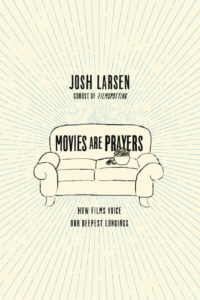 Movies Are Prayers: How Films Voice Our Deepest Longings (IVP) achieves something rather remarkable: author Josh Larsen is open and sincere about his Christian faith and examines the films in this volume through an overtly religious lens, yet the book’s tone and tenor are accessible and beneficial for all audiences interested in film criticism, religious or otherwise. This distinction is noted in the forward by Matt Zoller Seitz, who observes, “Much arts criticism is at best coolly secular or indifferent to faith, and at worst actively hostile to most forms of organized religion….a critic such as Larsen also encounters resistance (and sometimes hostility) from that sector of the audience that is mainly interested in knowing what sorts of films won’t offend their faith or their sense of propriety….” Having experienced such indifference or resistance myself, I greatly admire and learn from those film critics (Larsen, Alissa Wilkinson, Justin Chang, Ann Hornaday) who are faithful both to excellent criticism and their Christianity, and write for audiences wider than Christian circles. Larsen is both the co-host of Filmspotting, one of the more popular and consistently great film podcasts, as well as the editor for Think Christian. While these are two different gigs for differing audiences and purposes, Larsen does both splendidly and authenticity–he’s still the same Josh in both contexts, neither compromising his faith nor flaunting it inappropriately. Movies Are Prayers is written by this same Josh, and its tone of generosity and deep love for the arts shines through.
Movies Are Prayers: How Films Voice Our Deepest Longings (IVP) achieves something rather remarkable: author Josh Larsen is open and sincere about his Christian faith and examines the films in this volume through an overtly religious lens, yet the book’s tone and tenor are accessible and beneficial for all audiences interested in film criticism, religious or otherwise. This distinction is noted in the forward by Matt Zoller Seitz, who observes, “Much arts criticism is at best coolly secular or indifferent to faith, and at worst actively hostile to most forms of organized religion….a critic such as Larsen also encounters resistance (and sometimes hostility) from that sector of the audience that is mainly interested in knowing what sorts of films won’t offend their faith or their sense of propriety….” Having experienced such indifference or resistance myself, I greatly admire and learn from those film critics (Larsen, Alissa Wilkinson, Justin Chang, Ann Hornaday) who are faithful both to excellent criticism and their Christianity, and write for audiences wider than Christian circles. Larsen is both the co-host of Filmspotting, one of the more popular and consistently great film podcasts, as well as the editor for Think Christian. While these are two different gigs for differing audiences and purposes, Larsen does both splendidly and authenticity–he’s still the same Josh in both contexts, neither compromising his faith nor flaunting it inappropriately. Movies Are Prayers is written by this same Josh, and its tone of generosity and deep love for the arts shines through.
While much of film-and-theology literature is written from the perspective how God is encountered within the cinematic form, Larsen suggests that films are forms of prayers directed to God–films express our human longings and laments, our perplexity and our praise. He explores a wide variety of films not based on movie genres, but rather prayer postures and practices. There are prayers of praise (Avatar, Babette’s Feast, The Tree of Life), prayers of yearning (Casablanca, Interstellar, In the Mood for Love), prayers of lament (12 Years a Slave, No Country for Old Men, Chinatown), and a variety of others. It’s akin to reading a Dallas Willard or Richard Foster book on the discipline of prayer, only from a filmic perspective.
I greatly appreciated Larsen’s emphasis and celebration not only on the content of each film, but also on the form. He spends as much, if not more, space exploring the nuances of cinematography and editing as he does plot synopsis. In drawing connections and parallels to various prayer practices, form matters. Larsen is suggesting that how we pray–how films are made–are just as significant as what we pray. While on the surface this may feel obvious, the practices I’ve observed within evangelical Christian circles both to film-viewing and to prayer suggest that we have much to learn about the importance of form. Often the value of a film is judged by its objectionable content–the exercise of counting cuss words and sex scenes–rather than received and contemplated for its larger artistic merits. Similarly, some significant forms of prayer throughout church history–liturgy, meditation, lament, and especially contemplative prayer–have been met with skepticism at best, resistance or hostility at worst. In the chapter on “Prayers as Meditation and Contemplation,” Larsen considers film forms which cause us to slow down, so-called “boring” films in the vein of Robert Bresson or Carl Dreyer, or the experimental documentary Leviathan, a narrative-free deep dive into the intricacies of a fishing vessel. To be honest, both contemplative prayer and experimental or slow-paced black-and-white films are not easy. They might initially be boring. Yet in our frantic and busy culture, these films and prayers force us to adopt different rhythms and invite us to slow down and consider the beauty before us, to listen and see what the Divine might up to. In this, Movies Are Prayers is a welcome invitation to expand our horizons in both our movie-going and our prayer habits, to consider the forms which shape our character, and to celebrate what God is doing in our lives and our art. Generous and accessible, with a firm grasp of both film theory and theology, Movies Are Prayers is just the book I’d want to hand to students in a film-and-theology university course, a budding teenage cinephile, or those skeptical of religion yet open to the transcendent they’ve experienced in cinema.
Buy Movies Are Prayers: How Films Voice Our Deepest Longings from Amazon.
Leave a Reply